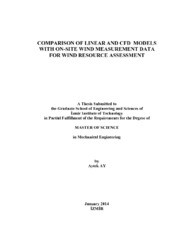Please use this identifier to cite or link to this item:
https://hdl.handle.net/11147/3651Full metadata record
| DC Field | Value | Language |
|---|---|---|
| dc.contributor.advisor | Özerdem, Mehmet Bariş | en |
| dc.contributor.author | Ay, Aytek | - |
| dc.date.accessioned | 2014-07-22T13:52:02Z | - |
| dc.date.available | 2014-07-22T13:52:02Z | - |
| dc.date.issued | 2014-01 | en |
| dc.identifier.uri | http://hdl.handle.net/11147/3651 | - |
| dc.description | Thesis (Master)--Izmir Institute of Technology, Mechanical Engineering, Izmir, 2014 | en |
| dc.description | Includes bibliographical references(leaves: 54-56) | en |
| dc.description | Text in English; Abstract: Turkish and English | en |
| dc.description | xiii, 56 leaves | en |
| dc.description | Full text release delayed at author's request until 2017.02.07 | en |
| dc.description.abstract | Wind resource assessment (WRA) estimates the strength of wind resources at a planned wind project site. The output of WRA is wind conditions and annual energy production at a wind project site. The aim of this study is to compare on-site measurements with a linear and non-linear flow model results by calculating the error values between and investigating the effects on the annual energy productions. Wind Atlas Analysis and Application Program (WAsP) is used for linear model approach, whilst software called WindSim is used for non-linear model approach based on computational fluid dynamics (CFD) concept. Relative and absolute wind speed errors which have been weighted with the frequency of the directions show that the CFD model gives better results. This non-linear model also leads in annual energy predictions with 1.8% relative error averaged over three met mast results which is 4.2% for linear model. Although non-linear results seem to be better in such a semi-complex site as a further study it is important to run several more test cases for sites with different complexity and stability conditions. The results of non-linear model have been obtained with a new post-processing tool created by Siemens Wind Power. It is also necessary to run the same calculation procedure for several more complex sites before using as a standard tool as this is the first test case of this calculation method. | en |
| dc.language.iso | en | en_US |
| dc.publisher | Izmir Institute of Technology | en |
| dc.rights | info:eu-repo/semantics/openAccess | en_US |
| dc.subject.lcsh | Wind power--Research | en |
| dc.subject.lcsh | Winds--Measurement | en |
| dc.subject.lcsh | Wind turbines--Mathematical models | en |
| dc.title | Comparison of linear and cfd models with on-site wind measurement data for wind resource assessment | en_US |
| dc.type | Master Thesis | en_US |
| dc.institutionauthor | Ay, Aytek | - |
| dc.department | Thesis (Master)--İzmir Institute of Technology, Mechanical Engineering | en_US |
| dc.relation.publicationcategory | Tez | en_US |
| item.languageiso639-1 | en | - |
| item.fulltext | With Fulltext | - |
| item.openairecristype | http://purl.org/coar/resource_type/c_18cf | - |
| item.openairetype | Master Thesis | - |
| item.grantfulltext | open | - |
| item.cerifentitytype | Publications | - |
| Appears in Collections: | Master Degree / Yüksek Lisans Tezleri | |
Files in This Item:
| File | Description | Size | Format | |
|---|---|---|---|---|
| 10021736.pdf | MasterThesis | 2.1 MB | Adobe PDF |  View/Open |
CORE Recommender
Page view(s)
1,216
checked on Jul 22, 2024
Download(s)
296
checked on Jul 22, 2024
Google ScholarTM
Check
Items in GCRIS Repository are protected by copyright, with all rights reserved, unless otherwise indicated.